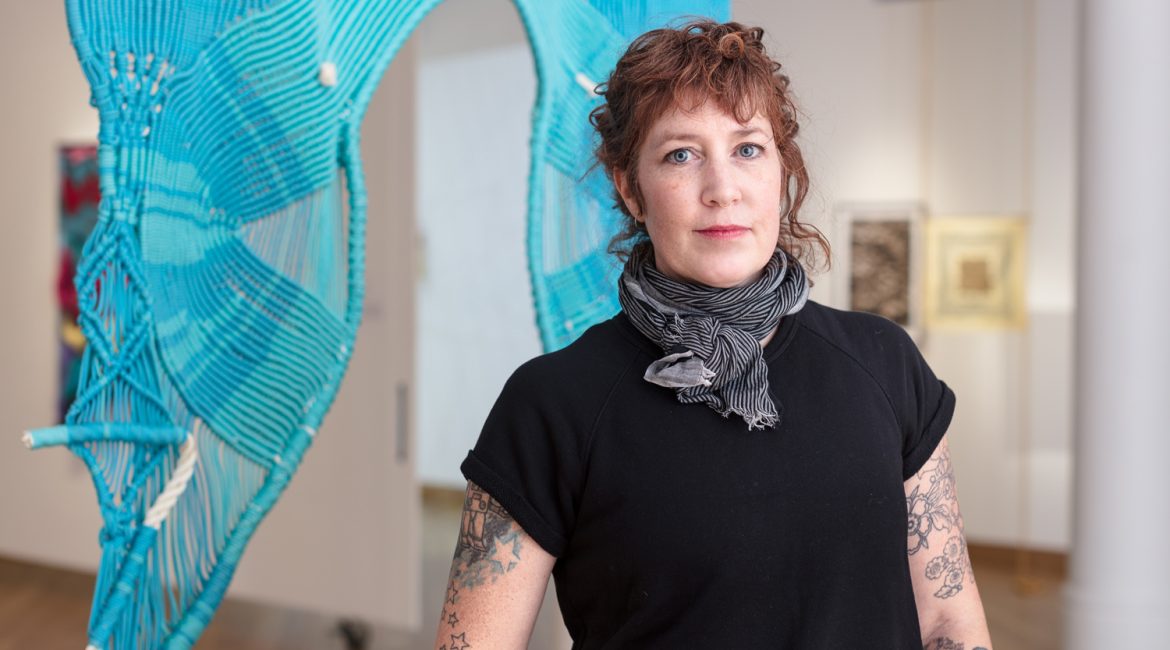Haptic Tactics is an exhibition at Leslie Lohman Museum in New York City that seeks to expand conceptions of queerness and desire beyond the specificity of same-sex object choice to the eroticism and sensuous qualities of materials, animate, and inanimate. The show particularly explores how the material and textural properties of artworks — how we imagine they were made and how they might physically feel — are potential and potent sites for queerness.
The three curators of the exhibition proposed a series of questions over email to Jesse Harrod, one of the artists included in the show, to begin exploring Harrod’s practice as well as the broader concerns of the show.
Jesse Harrod has an MFA from the department of Fibers & Material Studies from the School of The Art Institute of Chicago, a BFA from the Nova Scotia College of Art and Design University, and is currently the Head of Fibers & Material Studies Area at Tyler School of Art in Philadelphia.
Interview by Noam Parness, Daniel Sander, and Risa Puleo, Curators of Haptic Tactics, Leslie Lohman Museum
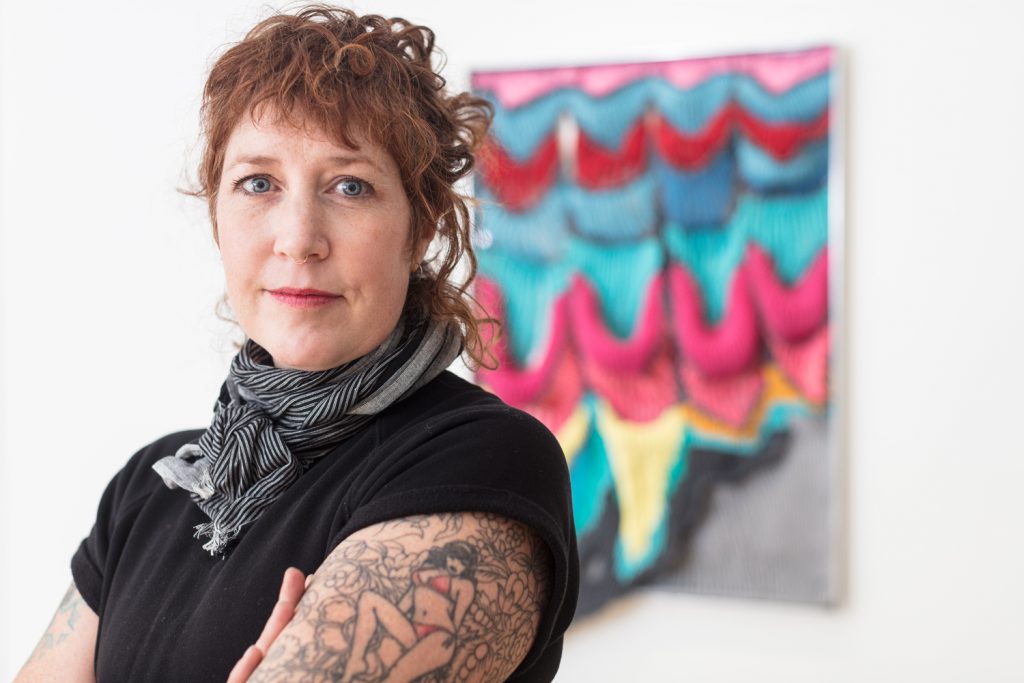
Jesse Harrod | Photo by Joe Kramm
What is your relation, in terms of touch, to the materials that you use?
Materials are enormously important to me. I am extremely committed to playing physical games and just being active in my body. The work I make allows me to be just that — for my hands to be engaged in complicated play with materials but also for my body to be engaged through the scale I tend to work at. I am not good at sitting still and making. I have to jump around between standing, sitting, getting on a ladder, and so on. I have to want to touch my materials. For example, some synthetics make my skin crawl, and they may well be more affordable, or do a better job, but if I can’t work with them, be intimate with them, then it’s not an option. I also spend time researching how and where the materials I use are made, under what circumstances, and their histories. This information factors heavily into the work and my choices.
How does feeling, both in the sense of touch and in the sense of affect, factor into your work?
It’s everything for me; they are tied together. I had pretty tough learning difficulties as a kid, in part because of having ADHD, so being physical and having something to occupy my physical self allowed other parts of me to learn and take in information. That is still the case. I can pay much better attention in a meeting if I can doodle or play with a string (like a cat!). I think because I figured this out as a kid, as an adult I have a strong connective tie between what my hands are making and how I am feeling.
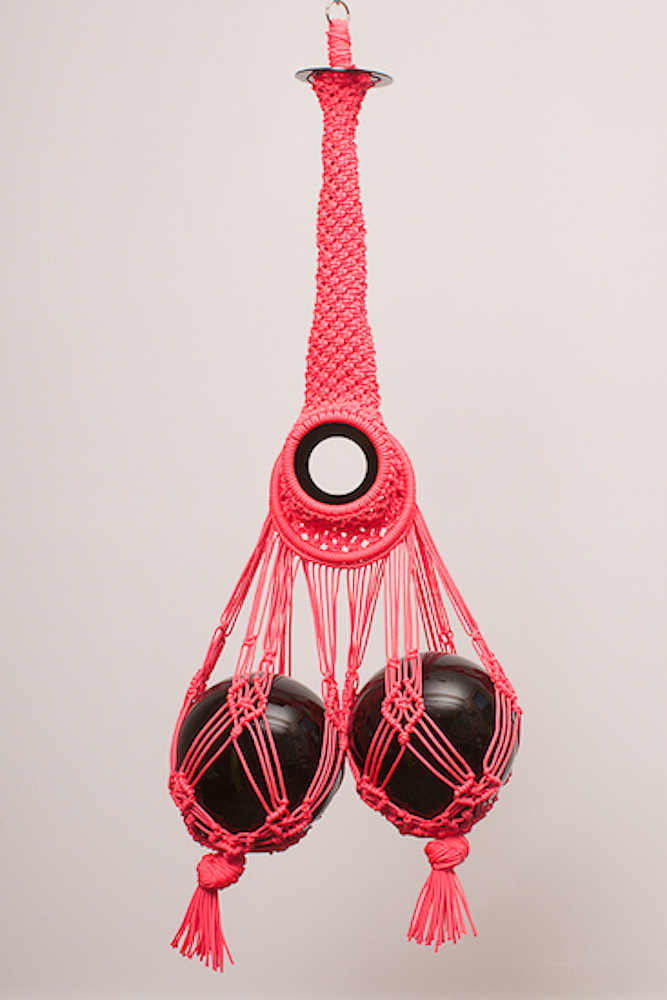 Jesse Harrod, Beads, 2015. Paracord, blown glass balls, and metal. 60 x 24 x 18 in.
Jesse Harrod, Beads, 2015. Paracord, blown glass balls, and metal. 60 x 24 x 18 in.
One way to think about haptics and the haptic is in relation to virtual reality. What is your relation to digitality? What are the similarities and differences of working with the digits (fingers) and working digitally?
I work digitally with stop motion. I am not as adept at that, and it requires my mind to work in different ways and to look at screens and numbers in boxes. That is really hard for me, so it’s tiring, and I get easily frustrated. I can’t feel my way through it because it is all thinking all the time. I think that’s crucial in my process — the difference between my hands just doing something that they are trained to do versus me having to figure out a path. For example, with knitting, which I don’t do anymore, I can knit really complicated patterns, and I don’t have to think about it. I can watch a movie, talk on the phone; my body is so well trained in doing this. To some extent, with knots or macrame, this can be true but less so, as I am creating the form as I go, not following steps. I am most interested in times when my body is trained to do something, but I also have to problem solve at the same time, times when there is a flow, a dance, among my hands, my mind, and the materials. I use technology because, in some cases, it’s the best way to make the work, but it’s a very different experience. I do draw a lot in Photoshop, and that’s a little different, as I am fairly comfortable with that interface, but the software for stop animation is taxing for sure. I can only do that kind of work in the morning when I am fresh and less likely to get frustrated! When using that type of technology, there is no dance happening; it’s a tug of war all the time.
In addition to specific technologies, another way to think about the virtual is in the sense of being virtually — as in almost — present, on the horizon. Is there a futural or utopian aspect to your work?
Yes, definitely. I really love the way you bring together the virtual with the utopian because one of the central aims of my practice is to think about the alternative and sometimes not yet realized potentials of the materials and material worlds that surround us. This is why I’m so drawn to detritus and things and people who are often discarded or cast off. What your question helps me think about is how understandings of utopia usually only look to the future and the new. I’m interested in challenging that.
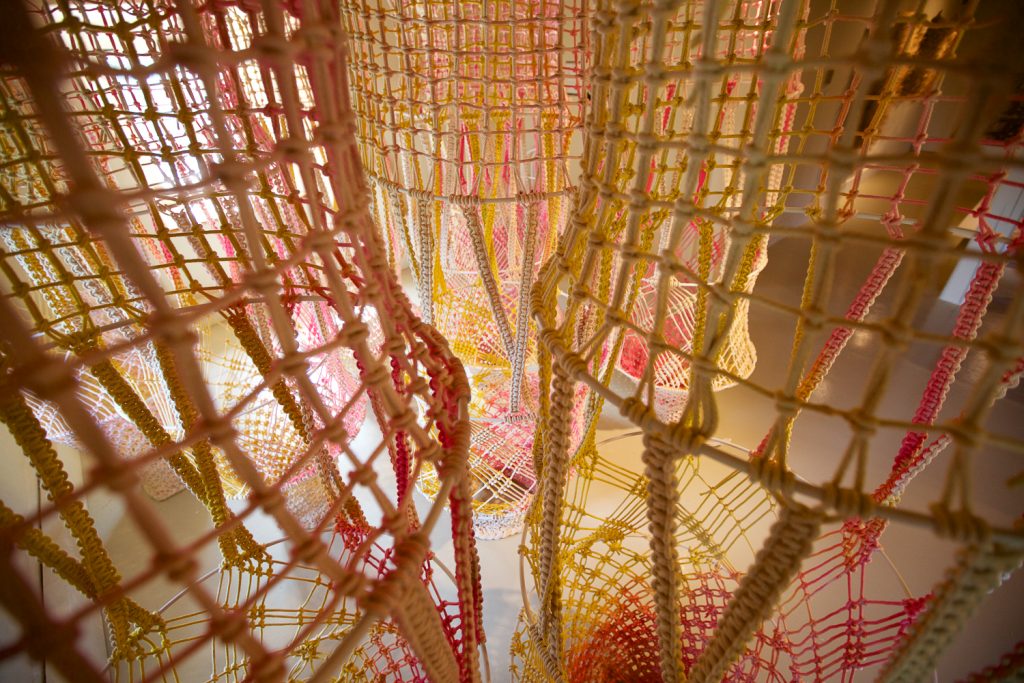 Jesse Harrod, Passing Fancies, 2017. Cotton, linen, and metal (nine parts). 96 x 20 in each.
Jesse Harrod, Passing Fancies, 2017. Cotton, linen, and metal (nine parts). 96 x 20 in each.
Could you talk about your relationship to macramé craft practices of the 1970s and rope play practiced by bondage communities?
When I started with the macramé, it was initially because of the relationship to my mother’s era and political concerns, but I also think about my own relationship to bondage communities. I often don’t see it myself and then a colleague will point it out, which always makes me laugh, not being able to see the forest for the trees. I think there is clearly a connection (although I would never use paracord on someone’s skin!), but I think it’s very much embedded in me. I am interested in the restraining in the macramé work and how the rope is under tension and reliant on itself or on the structure it’s mounted from. This is very much in keeping with how many forms of bondage work. I am adept at those types of knots and did study them, but I also worked on water, on boats, and obviously there is a connection among all of those ways to keep something fluid and moveable, safe and controlled. I am not looking at rope play as a source. I look more at shipping knots as a reference point. But mostly the way I work is to think of the rope as a line much like a drawing. I see the knots less than I see the line, if that makes any sense.
How do you see gender and sexuality playing out in your sculptural forms? Can sexuality extend beyond the bounds of people to include erotic relations to inanimate objects?
I think so, yes, that is the space that is most interesting to me and often the most erotic. I have very intimate relationships with my materials, as I mentioned. On a practical level, I spend more time holding and working them than I do anything else! I like to think of imbuing materials.
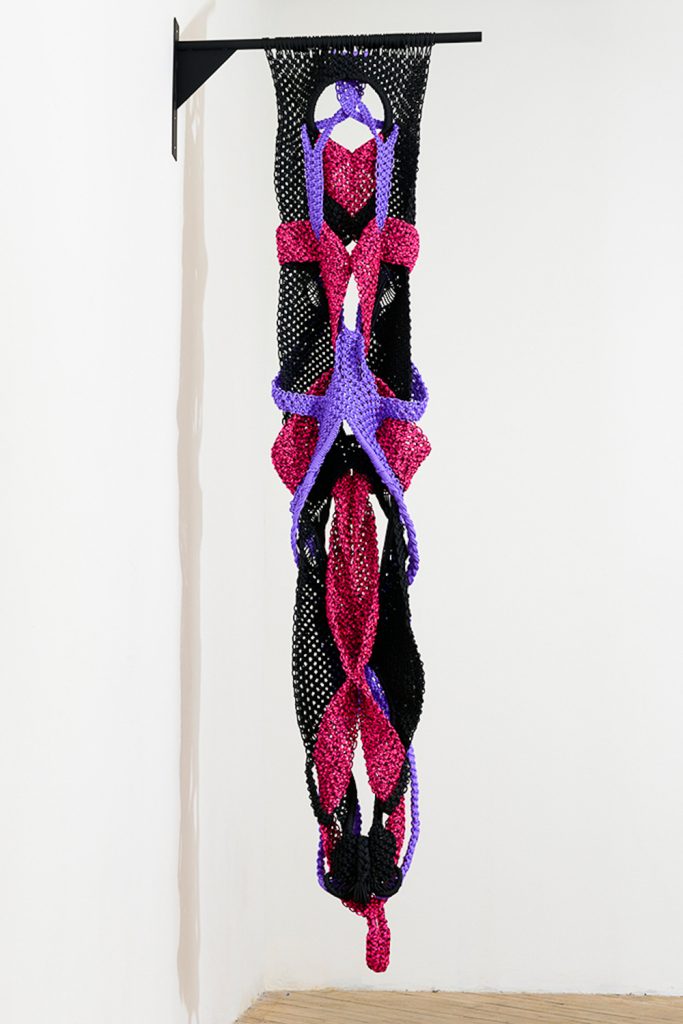
Jesse Harrod, Mascot 2, 2016. Paracord and metal. 72 x 17 in.
Do you see abstraction relating to the political at all, whether in your own work, or more generally? What is the relation of abstraction to corporeality? (Here we might think about the ways in which abstraction is sometimes a way for normative subjects to efface or transcend bodily difference and specificity in the name of a transcendent universalism. Or the ways in which there is a type of abstraction at work in racist, capitalist objectification.)
I don’t believe in hard and fast distinctions between abstraction and figurative, or realist, work. I think many artists have put abstraction to varying uses and that abstraction is not always about the transcendence or negation of identity but a way to think about the bodily forms that are imperceptible according to existing regimes of the gendered, raced, sexed, or abled-body.
Has ‘queer’ been a useful term for you and your work?
I am queer, so it’s useful to me, as it helps describe my identity. I don’t know how useful it is in the work. Certainly I think a lot about survival and how queer folks like myself are surviving. I am interested in queer turns that work makes and using materials in non-normative ways and how that can queer a space etc. but I don’t go out with that as the intention. The work is likely read as queer because I made it, my politics etc. This is something I always struggle to talk about, as often my work is read as very queer, but it’s really up to who is doing the looking. Like I said, I don’t set out to make it queer, I just make the work.
Haptic Tactics is on view at Leslie Lohman Museum in New York City until May 20th. For more information please visit leslielohman.org/project/haptic-tactics.
Editorial Credits
Photography: Joe Kramm
Senior Photo Director: Asher Torres
Become a Posture Member
Support independent media and become an official Posture member! Membership includes our special annual print edition ($20 value), free and/or discounted entry to all Posture events in NYC (including upcoming mixers, panel discussions, and networking opportunities), special offers from our partners, personal updates from the Posture team, and more.
Click here to learn more and join today!

